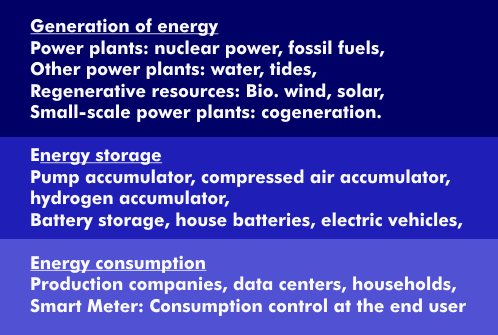smart grid (SG)
Smart Grid(SG) or Smart Power Grid refers to intelligent distribution networks for power supply in which the energy supply is adapted to the energy feed-in and consumption. These energy networks are about demand-oriented and efficient energy distribution of centrally and decentrally fed energy and about controlling consumption behavior.
Smart grids are nationwide, transnational power grids that receive their energy from baseload plants, hydroelectric plants, renewable energy power plants, and distributed energy resources( DER), which are micro power plants owned by end users, and control consumption based on demand.
Classification of smart grids
Smart grids are classified according to their extent into super grids, smart grids, and micro grids. Super gr ids are transmission networks that span countries and continents and extend across Europe to North Africa. Existing high- voltage and low-voltage grids and lines for high-voltage direct- current( HVDC) transmission are available for energy transmission. Smart grids, on the other hand, are intelligent distribution networks that connect existing conventional power plants and renewable energy power plants with large-scale consumers and microgrids. Microgrids are regional energy systems with decentralized power generators of the utilities, with electrical energy storage and consumers.
Load management in smart grids
Smart grids are designed to balance the highly fluctuating energy feeds from solar, wind and biogas plants into existing power grids, and also to increase efficiency. Thanks to their intelligence, smard-grid networks can make forecasts of feed-in and consumption, control the storage of surplus energy, and balance power distribution through load management. They can create feed-in and consumption profiles and then optimize energy supply. In addition to load management, it also involves automated grid management and maintenance.
Conceptually, a smart grid is a complex network where all data streams for energy supply converge. At all feed-in points and consumption points, data is collected by sensors and made available to the Distribution Management System( DMS) and Demand Side Management( DSM). The concept extends to the end consumer, who is equipped with intelligent electricity meters, the smart meters, and uses smart metering to record his or her own consumption behavior and can influence this through special tariffs.
Energy storage in smart grids
A crucial aspect of smart grids is energy storage. For this purpose, home storage, battery banks, capacitor banks and electric vehicle batteries can be integrated into energy storage for low-voltage grids. The latter is referred to as vehicle to grid( V2G). In the V2G concept, the batteries of electric vehicles are to store energy by means of smart charging and, during peak loads, to release it to the smart grid by means of regeneration.
Communication in smart grids
The communication infrastructures of smart grids have emerged from the various grid concepts. If it is local area networks( LAN) at the utility companies, the main and substations communicate via wide area networks(WAN), the AMI systems and field devices via Neighborhood Area Networks( NAN) and Field Area Networks( FAN), and the consumer-side metering devices via Home Area Networks( HAN). With JupiterMesh, a special Wireless Mesh Network( WMN) is available for the control and management of smart grids, which is based on existing ZigBee standards.
As far as communication protocols are concerned, Powerline is used in the narrowbandG3-PLCvariant, but classic communication protocols are also used.
IEEE standardizes the topic of smart grids under the P2030 standard with the title: "IEEE Guide for Smart Grid Interoperability of Energy Technology and Information Technology Operation with the Electric Power System( EPS), and End-use Applications and Loads ". In addition, IEEE has established a Technical Advisory Group called IEEE 802.24 to bring IEEE 802 activities to smart grid communications.

